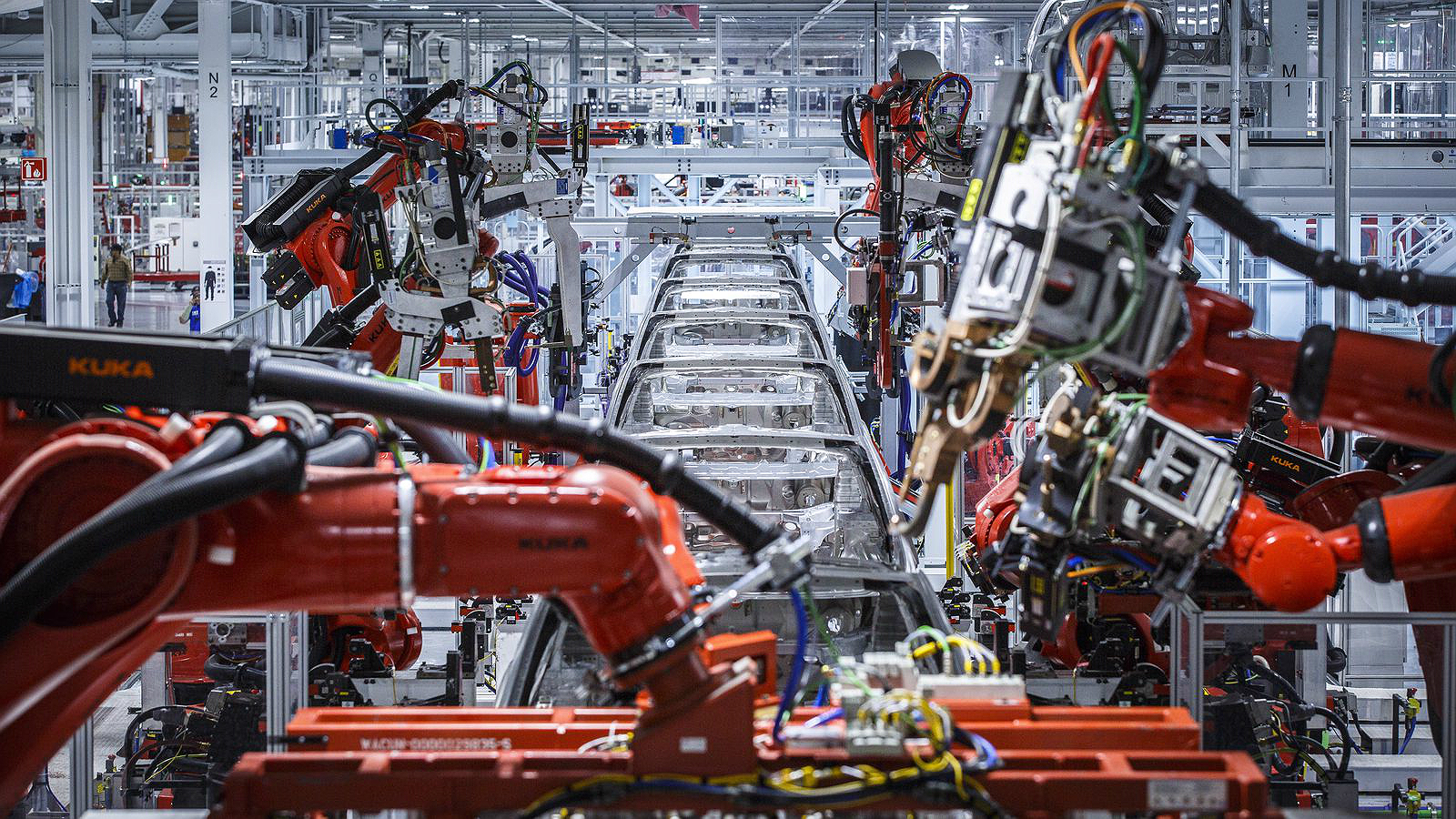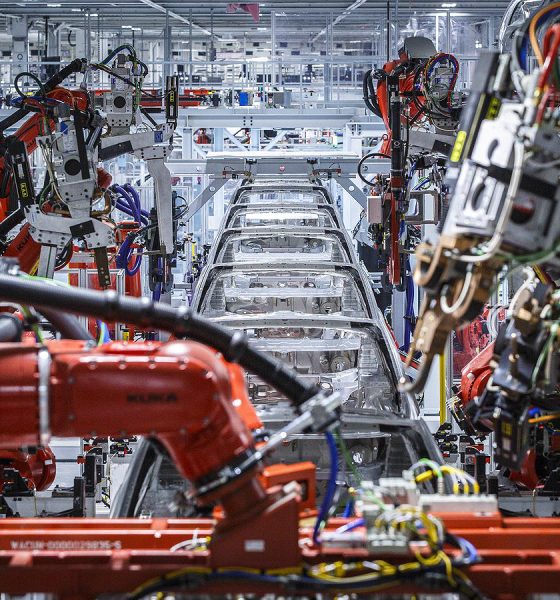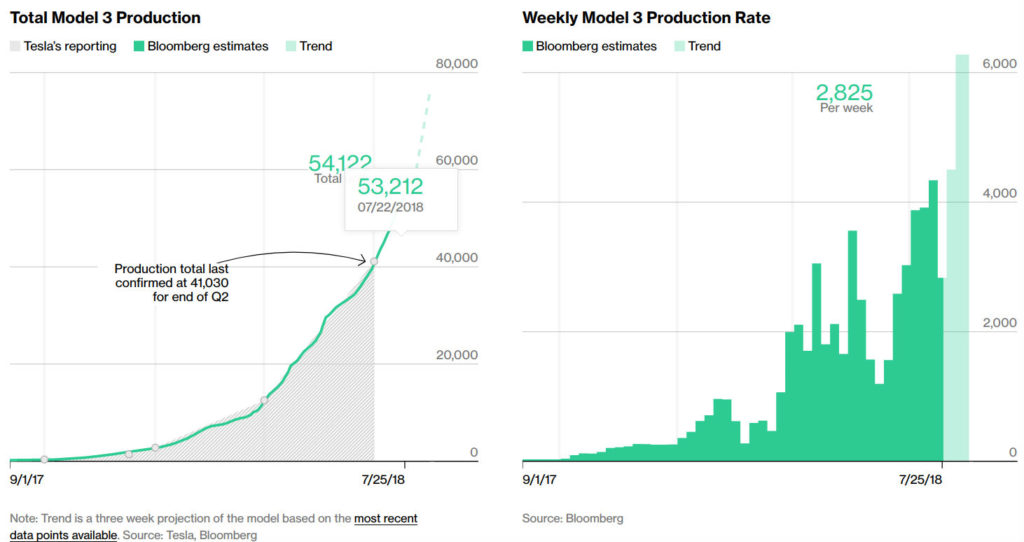

Investor's Corner
Tesla seems to be preparing the Model 3 for a 6,000/week production push
As Tesla heads towards its Q2 2018 financial results and earnings call, the electric car maker seems to be showing signs that it is gearing up for yet another significant Model 3 production push.
In an interview with Bloomberg Businessweek earlier this month, Elon Musk described the Model 3 ramp as a “bet-the-company” situation — a scenario in which the vehicle’s failure would equate to Tesla’s likely collapse. It was a risky gamble, and it gave Musk what he called “permanent mental scar tissue,” but with the company’s milestone at the end of Q2 2018, when it managed to produce 5,000 Model 3 per week, the end of Tesla’s manufacturing hell appears to be within reach.
To fully get out of production hell, Tesla would need to manufacture the Model 3 at scale and at a sustainable rate — a feat that has proven incredibly challenging for the electric car maker. Over the first half of July, signs were abounding that Tesla was once more defying the odds and maintaining its optimum manufacturing rate for the electric car, with mass sightings of Model 3 being transported, test drives for the vehicle being offered, and mass VIN registrations numbering more than 19,000 being filed in a two-week period. If Bloomberg‘s ever-evolving Model 3 tracker is any indication, however, Tesla’s production rate for the electric car appears to have tapered down recently.

While the recent production drop suggested in Bloomberg‘s tracker might appear negative, the publication’s model also forecasts an upcoming spike in Model 3 production. As of writing, a projection for the next few weeks points to Tesla manufacturing 6,000 Model 3 per week. Over the past few months, these instances of slowdowns followed by sudden bursts that reach record production levels have happened several times. In Q2, shutdowns of the Model 3 line corresponded to the installation of upgrades that gave Tesla the capacity to produce more vehicles than before.
Back in April, Tesla shut down the production of the Model 3 to roll out improvements that enabled the company to hit a manufacturing rate of 3,000-4,000 vehicles per week. In May, another set of upgrades were installed that allowed Tesla to get closer to its then-elusive target of producing 5,000 Model 3 per week. Based on the rationale behind Tesla’s previous production shutdowns, it appears that the electric car maker could be in the process of improving the capacity of its Model 3 line once more.
In a way, the slowdown in production reflected in Bloomberg‘s tracker was teased in Tesla Senior Director of Investor Relations Aaron Chew’s meeting with investors and analysts earlier this month. During the meeting, Chew reportedly noted that Tesla is aiming to hit a sustainable production rate of 5,000-6,000 Model 3 for the rest of the third quarter. After this point, Tesla’s ramp for the vehicle would be less radical, with the company reportedly targeting a pace of 7,000 cars per week for Q4 2018, and 10,000 Model 3 per week by mid-2019. Chew also reportedly noted that Tesla’s GA3 assembly line was only running at ~4,000 vehicles per week at the end of Q2 2018, and that the company was only able to hit its 5,000 Model 3 per week target because of an extra ~1,000 vehicles that were manufactured from GA4. Thus, Tesla’s recent slowdown in Model 3 production could correspond to the installation of upgrades for GA3 that would allow it to produce a steady rate of 5,000, or even 6,000 vehicles per week on its own. If these assumptions prove correct, Bloomberg‘s forecast pointing to a 6,000 Model 3 production week definitely becomes plausible.
Tesla is currently attempting to hit profitability this third quarter. To accomplish this goal, the Model 3’s production has to be optimized. Teardowns of the vehicle, both from Germany and in the United States have been unanimous in the conclusion that the Model 3 is profitable. Detroit’s Sandy Munro even noted that the Long Range RWD version of the vehicle could give Tesla as much as 36% worth of profits. At this point, the only thing standing between Tesla and profitability is its capability to scale and sustain the Model 3’s production. If the company achieves this, it would likely prove to be a hard-fought victory for Elon Musk and the Tesla team.

Investor's Corner
Tesla Q4 delivery numbers are better than they initially look: analyst
The Deepwater Asset Management Managing Partner shared his thoughts in a post on his website.

Longtime Tesla analyst and Deepwater Asset Management Managing Partner Gene Munster has shared his insights on Tesla’s Q4 2025 deliveries. As per the analyst, Tesla’s numbers are actually better than they first appear.
Munster shared his thoughts in a post on his website.
Normalized December Deliveries
Munster noted that Tesla delivered 418k vehicles in the fourth quarter of 2025, slightly below Street expectations of 420k but above the whisper number of 415k. Tesla’s reported 16% year-over-year decline, compared to +7% in September, is largely distorted by the timing of the tax credit expiration, which pulled forward demand.
“Taking a step back, we believe September deliveries pulled forward approximately 55k units that would have otherwise occurred in December or March. For simplicity, we assume the entire pull-forward impacted the December quarter. Under this assumption, September growth would have been down ~5% absent the 55k pull-forward, a Deepwater estimate tied to the credit’s expiration.
“For December deliveries to have declined ~5% year over year would imply total deliveries of roughly 470k. Subtracting the 55k units pulled into September results in an implied December delivery figure of approximately 415k. The reported 418k suggests that, when normalizing for the tax credit timing, quarter-over-quarter growth has been consistently down ~5%. Importantly, this ~5% decline represents an improvement from the ~13% declines seen in both the March and June 2025 quarters.“
Tesla’s United States market share
Munster also estimated that Q4 as a whole might very well show a notable improvement in Tesla’s market share in the United States.
“Over the past couple of years, based on data from Cox Automotive, Tesla has been losing U.S. EV market share, declining to just under 50%. Based on data for October and November, Cox estimates that total U.S. EV sales were down approximately 35%, compared to Tesla’s just reported down 16% for the full quarter. For the first two months of the quarter, Cox reported Tesla market share of roughly a 65% share, up from under 50% in the September quarter.
“While this data excludes December, the quarter as a whole is likely to show a material improvement in Tesla’s U.S. EV market share.“
Elon Musk
Tesla analyst breaks down delivery report: ‘A step in the right direction’
“This will be viewed as better than feared deliveries and a step in the right direction for the Tesla story heading into 2026,” Ives wrote.

Tesla analyst Dan Ives of Wedbush released a new note on Friday morning just after the company released production and delivery figures for Q4 and the full year of 2025, stating that the numbers, while slightly underwhelming, are “better than feared” and as “a step in the right direction.”
Tesla reported production of 434,358 and deliveries of 418,227 for the fourth quarter, while 1,654,667 vehicles were produced and 1,636,129 cars were delivered for the full year.
Tesla releases Q4 and FY 2025 vehicle delivery and production report
Interestingly, the company posted its own consensus figures that were compiled from various firms on its website a few days ago, where expectations were set at 1,640,752 cars for the year. Tesla fell about 4,000 units short of that. One of the areas where Tesla excelled was energy deployments, which totaled 46.7 GWh for the year.
🚨 Wedbush’s Dan Ives has released a new note on Tesla $TSLA:
“Tesla announced its FY4Q25 delivery numbers this morning coming in at 418.2k vehicles slightly below the company’s consensus delivery estimate of 422.9k but much better than the whisper numbers of ~410k as the…
— TESLARATI (@Teslarati) January 2, 2026
In terms of vehicle deliveries, Ives writes that Tesla certainly has some things to work through if it wants to return to growth in that aspect, especially with the loss of the $7,500 tax credit in the U.S. and “continuous headwinds” for the company in Europe.
However, Ives also believes that, given the delivery numbers, which were on par with expectations, Tesla is positioned well for a strong 2026, especially with its AI focus, Robotaxi and Cybercab development, and energy:
“This will be viewed as better than feared deliveries and a step in the right direction for the Tesla story heading into 2026. We look forward to hearing more at the company’s 4Q25 call on January 28th. AI Valuation – The Focus Throughout 2026. We believe Tesla could reach a $2 trillion market cap over the coming year and, in a bull case scenario, $3 trillion by the end of 2026…as full-scale volume production begins with the autonomous and robotics roadmap…The company has started to test the all-important Cybercab in Austin over the past few weeks, which is an incremental step towards launching in 2026 with important volume production of Cybercabs starting in April/May, which remains the golden goose in unlocking TSLA’s AI valuation.”
It’s no secret that for the past several years, Tesla’s vehicle delivery numbers have been the main focus of investors and analysts have looked at them as an indicator of company health to a certain extent. The problem with that narrative in 2025 and 2026 is that Tesla is now focusing more on the deployment of Full Self-Driving, its Optimus project, AI development, and Cybercab.
While vehicle deliveries still hold importance, it is more crucial to note that Tesla’s overall environment as a business relies on much more than just how many cars are purchased. That metric, to a certain extent, is fading in importance in the grand scheme of things, but it will never totally disappear.
Ives and Wedbush maintained their $600 price target and an ‘Outperform’ rating on the stock.
Investor's Corner
Tesla releases Q4 and FY 2025 vehicle delivery and production report
Deliveries stood at 406,585 Model 3/Y and 11,642 other models, for a total of 418,227 vehicles.

Tesla (NASDAQ:TSLA) has reported its Q4 2025 production and deliveries, with 418,227 vehicles delivered and 434,358 produced worldwide. Energy storage deployments hit a quarterly record at 14.2 GWh.
Tesla’s Q4 and FY 2025 results were posted on Friday, January 2, 2026.
Q4 2025 production and deliveries
In Q4 2025, Tesla produced 422,652 Model 3/Y units and 11,706 other models, which are comprised of the Model S, Model X, and the Cybertruck, for a total of 434,358 vehicles. Deliveries stood at 406,585 Model 3/Y and 11,642 other models, for a total of 418,227 vehicles.
Energy deployments reached 14.2 GWh, a new record. Similar to other reports, Tesla posted a company thanked customers, employees, suppliers, shareholders, and supporters for its fourth quarter results.
In comparison, analysts included in Tesla’s company-compiled consensus estimate that Tesla would deliver 422,850 vehicles and deploy 13.4 GWh of battery storage systems in Q4 2025.
Tesla’s Full Year 2025 results
For the full year, Tesla produced a total of 1,654,667 vehicles, comprised of 1,600,767 Model Y/3 and 53,900 other models. Tesla also delivered 1,636,129 vehicles in FY 2025, comprised of 1,585,279 Model Y/3 and 50,850 other models. Energy deployments totaled 46.7 GWh over the year.
In comparison, analysts included in Tesla’s company-compiled consensus expected the company to deliver a total of 1,640,752 vehicles for full year 2025. Analysts also expected Tesla’s energy division to deploy a total of 45.9 GWh during the year.
Tesla will post its financial results for the fourth quarter of 2025 after market close on Wednesday, January 28, 2026. The company’s Q4 and FY 2025 earnings call is expected to be held on the same day at 4:30 p.m. Central Time.








